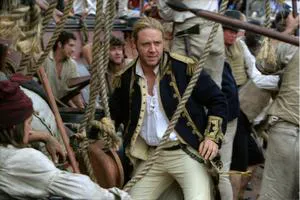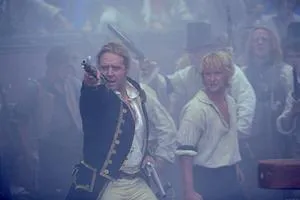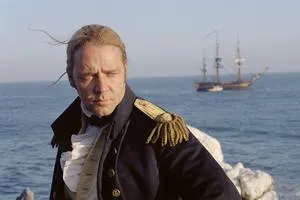Master and Commander: The Far Side of the World - A Timeless Tale of Freedom and Harmony

The enduring appeal of “Master and Commander: The Far Side of the World” lies in its unyielding focus on freedom, rather than any contrived sense of constraint. What does it matter that the plot revolves around a classic chase, with the valiant Captain Jack Aubrey relentlessly pursuing a superior French privateer? Or that the narrative hinges on the unpredictable whims of nature, as the HMS Surprise navigates the southern seas in pursuit of the Acheron through scorching heat, biting cold, raging storms, and becalmed doldrums?
Even the fact that the storms are conjured through Hollywood’s computer-generated wizardry and tank-based simulations is rendered inconsequential. The sets and models of the Surprise and Acheron were brought to life by a crew with experience on films like “Point Break” and “The Perfect Storm”, individuals who understand the raw power of the open ocean. Russell Crowe, in preparation for his role, even spent time sailing on a yacht coincidentally named “Surprise.”
The film’s meticulous, cinematic editing, far removed from the world of video games, seamlessly blends the studio tanks with the exotic landscapes of the Galapagos Islands and ethereal mists. This elevates the role of the weather to a level on par with the actors’ performances. Everything works in perfect harmony.
A Brotherhood Forged at Sea
The relentless pursuit unfolds over two and a half hours, devoid of the usual distractions of female characters, espionage, or dubious backstories. The film’s multi-faceted portrayal of men engaged in their duties, even in the early 19th century and in the remote southern seas, strikes a chord with anyone who has ever been engrossed in their own work, regardless of their background or profession.

Leaving behind the superficiality of modern life, even for a brief cigarette break, often feels like a denial of its very existence. But stepping away from “Master and Commander,” one can be confident that the film continues to exist in its own right, a self-contained and compelling world. This rare sense of assurance is complemented by personal associations that resonate with each viewer.
While I don’t claim to be an expert on nautical terminology, I can’t help but highlight some of the film’s most impactful elements. The dynamic between Russell Crowe’s Captain Aubrey and Paul Bettany’s Dr. Maturin, a study in contrasts between conformist and radical, pragmatist and intellectual, feels remarkably authentic, especially considering the exceptional talents of both actors. Their shared passion for music, culminating in a dilettantish yet heartfelt duet of Corelli, embodies the ideal of human connection.
Any potential sequel should steer clear of tired tropes like the “surviving enemy” and instead focus on the complex truth of their “friendly” powder keg of a relationship. Bettany’s doctor isn’t simply a sounding board for Crowe’s captain, and Crowe’s authority isn’t absolute. The doctor’s suppressed emotions will inevitably surface, leading to a dramatic explosion. Whether this aligns with Patrick O’Brian’s original vision, I cannot say, but it feels undeniably true to the spirit of the film.
A Microcosm of Society

Equally compelling are the characters of Midshipman Blakeney (the one-armed sailor) and Midshipman Hollom (the suicidal one). They embody a microcosm of the captain-doctor dynamic. Blakeney, a cherubic 13-year-old (played by Max Pirkis), seamlessly integrates into the crew and commands respect, while Hollom (played by Lee Ingleby) is observant and diligent, perhaps even more so than the captain, but is branded a “Jonah.”
Like Jonah in the belly of the whale, Hollom is destined for misfortune. Through subtle details – a gray-haired sailor whose pronouncements are taken as omens, a handsome French corpse, lively songs and drunken revelry, and fleeting encounters with native women – “Master and Commander” constructs a realistic model of society. At sea, social problems are genuinely addressed, and harmony, though hard-won, prevails. This is what makes this seemingly boyish adventure so captivating.
A Romantic Vision

The scenes of the doctor and Blakeney, accompanied by a sailor, capturing lizards and a cormorant, the sudden sighting of the Acheron, and the hasty abandonment of their pursuit, are all beautifully shot in frontal compositions. Some frames are simply breathtaking. And when the inevitable boarding action occurs, it’s a visceral experience involving cannons, muskets, swords, and hand-to-hand combat. Peter Weir’s film presents itself as a boyish adventure, but it is underpinned by a sophisticated understanding of romanticism.
Perhaps the film’s wealth of associations stems from a collective longing for a time when romanticism wasn’t dismissed as outdated. It’s been roughly two decades since Francis Fukuyama, in “The End of History,” declared that romanticism had no place in modern life, that it should be shunned in favor of pragmatism. “Master and Commander” reminds us that romanticism, in its purest form, still holds a powerful allure.